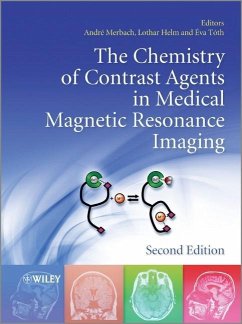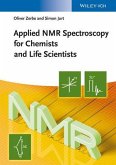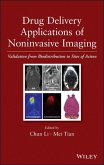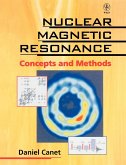Andre S. Merbach, Lothar Helm, Éva Tóth
The Chemistry of Contrast Agents in Medical Magnetic Resonance Imaging
Andre S. Merbach, Lothar Helm, Éva Tóth
The Chemistry of Contrast Agents in Medical Magnetic Resonance Imaging
- Gebundenes Buch
- Merkliste
- Auf die Merkliste
- Bewerten Bewerten
- Teilen
- Produkt teilen
- Produkterinnerung
- Produkterinnerung
Magnetic Resonance Imaging (MRI) is one of the most importanttools in clinical diagnostics and biomedical research. Thiscompletely revised and extended second edition is presented incolor and includes new chapters on targeted, responsive, PARACESTand nanoparticle MRI contrast agents. It covers the basicchemistries, MR physics and most important techniques used bychemists in the characterization of MRI agents from every angle,from synthesis to safety considerations. Essential readingfor professionals involved in the development and application ofcontrast agents in MRI.
Andere Kunden interessierten sich auch für
![Applied NMR Spectroscopy for Chemists and Life Scientists Applied NMR Spectroscopy for Chemists and Life Scientists]() Oliver ZerbeApplied NMR Spectroscopy for Chemists and Life Scientists51,99 €
Oliver ZerbeApplied NMR Spectroscopy for Chemists and Life Scientists51,99 €![Magnetic Resonance Microscopy Magnetic Resonance Microscopy]() Magnetic Resonance Microscopy180,56 €
Magnetic Resonance Microscopy180,56 €![Medical Imaging for Health Professionals Medical Imaging for Health Professionals]() Medical Imaging for Health Professionals226,99 €
Medical Imaging for Health Professionals226,99 €![Theory and Applications of Heat Transfer in Humans, 2 Volume Set Theory and Applications of Heat Transfer in Humans, 2 Volume Set]() Theory and Applications of Heat Transfer in Humans, 2 Volume Set288,99 €
Theory and Applications of Heat Transfer in Humans, 2 Volume Set288,99 €![Drug Delivery Applications of Noninvasive Imaging Drug Delivery Applications of Noninvasive Imaging]() Mei TianDrug Delivery Applications of Noninvasive Imaging216,99 €
Mei TianDrug Delivery Applications of Noninvasive Imaging216,99 €![Medical Imaging Based on Magnetic Fields and Ultrasounds Medical Imaging Based on Magnetic Fields and Ultrasounds]() Medical Imaging Based on Magnetic Fields and Ultrasounds191,99 €
Medical Imaging Based on Magnetic Fields and Ultrasounds191,99 €![Nuclear Magnetic Resonance Nuclear Magnetic Resonance]() Daniel CanetNuclear Magnetic Resonance219,99 €
Daniel CanetNuclear Magnetic Resonance219,99 €-
-
-
Magnetic Resonance Imaging (MRI) is one of the most importanttools in clinical diagnostics and biomedical research. Thiscompletely revised and extended second edition is presented incolor and includes new chapters on targeted, responsive, PARACESTand nanoparticle MRI contrast agents. It covers the basicchemistries, MR physics and most important techniques used bychemists in the characterization of MRI agents from every angle,from synthesis to safety considerations. Essential readingfor professionals involved in the development and application ofcontrast agents in MRI.
Hinweis: Dieser Artikel kann nur an eine deutsche Lieferadresse ausgeliefert werden.
Hinweis: Dieser Artikel kann nur an eine deutsche Lieferadresse ausgeliefert werden.
Produktdetails
- Produktdetails
- Verlag: Wiley & Sons / Wiley-Blackwell
- Artikelnr. des Verlages: 1W119991760
- 2. Aufl.
- Seitenzahl: 512
- Erscheinungstermin: 5. April 2013
- Englisch
- Abmessung: 254mm x 192mm x 32mm
- Gewicht: 1245g
- ISBN-13: 9781119991762
- ISBN-10: 1119991765
- Artikelnr.: 36697971
- Herstellerkennzeichnung
- Produktsicherheitsverantwortliche/r
- Europaallee 1
- 36244 Bad Hersfeld
- gpsr@libri.de
- Verlag: Wiley & Sons / Wiley-Blackwell
- Artikelnr. des Verlages: 1W119991760
- 2. Aufl.
- Seitenzahl: 512
- Erscheinungstermin: 5. April 2013
- Englisch
- Abmessung: 254mm x 192mm x 32mm
- Gewicht: 1245g
- ISBN-13: 9781119991762
- ISBN-10: 1119991765
- Artikelnr.: 36697971
- Herstellerkennzeichnung
- Produktsicherheitsverantwortliche/r
- Europaallee 1
- 36244 Bad Hersfeld
- gpsr@libri.de
Lothar Helm studied physics at the University of Karlsruhe and got his diploma in 1977 in physical chemistry and electrochemistry. In 1980 he obtained his Ph.D. and joined the Institute of Inorganic Chemistry at the University of Lausanne as post-doc. In 1999 he was appointed Privat Docent at the Faculty of Science of the University of Lausanne. Since 2006 he is titular professor and director of the NMR service of the Institute of Chemical Sciences and Engineering. André E. Merbach, studied at the University of Lausanne and in 1964 was awarded a PhD. He then spent a Postdoctoral Fellowship in the Lawrence Radiation Laboratory at UC Berkeley. In 1965 he returned to the Institute of Inorganic and Analytical Chemistry at Lausanne and created a research and teaching program in coordination chemistry. In 1973, the Swiss Chemical Society awarded him the Werner Prize and Medal for his research and he was nominated Professor of Inorganic and Analytical Chemistry. éva T?th of the Centre de Biophysique Moleculaire, CNRS, Orleans, France, received her Ph.D. in 1994 at the University of Debrecen, Germany and then from 1995-2000 carried out post-doctoral research at the University of Lausanne with Professor Merbach. From 2001-2005 she was based at the EPFL before taking up the position of Director of Research at the CBM in Orleans. She has over 80 journal papers, 4 book chapters as well as acting as co-editor for the 1st edition of this book which was published in 2001.
List of Contributors xiii Preface xv 1 General Principles of MRI 1 Bich-Thuy Doan, Sandra Meme, and Jean-Claude Beloeil 1.1 Introduction 1 1.2 Theoretical basis of NMR 1 1.2.1 Short description of NMR 1 1.2.2 Relaxation times 4 1.2.3 Saturation transfer 4 1.2.4 Concept of localization by magnetic field gradients 4 1.3 Principles of magnetic resonance imaging 5 1.3.1 Spatial encoding 5 1.4 MRI pulse sequences 11 1.4.1 Definition 11 1.4.2 k-Space trajectory 12 1.4.3 Basic pulse sequences 13 1.5 Basic image contrast: Tissue characterization without injection of contrast agents (main contrast of an MRI sequence: Proton density (P), T1 and T2, T
2) 16 1.5.1 Proton density weighting 17 1.5.2 T1 weighting 17 1.5.3 T2 weighting 17 1.5.4 T
2 weighting 18 1.6 Main contrast agents 18 1.6.1 Gadolinium (Gd) complex agents 19 1.6.2 Iron oxide (IO) agents 19 1.6.3 CEST agents 20 1.7 Examples of specialized MRI pulse sequences for angiography (MRA) 21 1.7.1 Time of flight angiography: No contrast agent 21 1.7.2 Angiography using intravascular contrast agent (Blood pool CA) injection 21 1.7.3 DSC DCE MRI 23 References 23 2 Relaxivity of Gadolinium(III) Complexes: Theory and Mechanism 25 E
va Töth, Lothar Helm, and Andre
Merbach 2.1 Introduction 25 2.2 Inner-sphere proton relaxivity 28 2.2.1 Hydration number and hydration equilibria 31 2.2.2 Gd-H distance 37 2.2.3 Proton/water exchange 39 2.2.4 Rotation 57 2.3 Second- and outer-sphere relaxation 64 2.4 Relaxivity and NMRD profiles 66 2.4.1 Fitting of NMRD profiles 66 2.4.2 Relaxivity of low-molecular-weight Gd(III) complexes 68 2.4.3 Relaxivity of macromolecular MRI contrast agents 69 2.4.4 Contrast agents optimized for application at high magnetic field 73 2.5 Design of high relaxivity agents: Summary 75 References 76 3 Synthesis and Characterization of Ligands and their Gadolinium(III) Complexes 83 Jan Kotek, Vojt¢§ech Kub
(c)¥¢§cek, Petr Hermann, and Ivan Luke¢§s 3.1 Introduction - general requirements for the ligands and complexes 83 3.2 Contrast agents employing linear polyamine scaffold 84 3.2.1 Synthesis of linear polyamine backbone 85 3.2.2 N-functionalization of linear polyamine scaffold 89 3.3 Contrast agents employing cyclen scaffold 103 3.3.1 Synthesis of the macrocyclic skeleton 103 3.3.2 N-functionalization of macrocyclic scaffold 106 3.4 Other types of ligands 123 3.4.1 H4TRITA and related ligands 123 3.4.2 H3PCTA and related ligands 123 3.4.3 TACN derivatives 126 3.4.4 Ligands with HOPO coordinating arms and related groups 130 3.4.5 H4AAZTA and related ligands 133 3.5 Bifunctional ligands and their conjugations 134 3.6 Synthesis and characterization of the Ln(III) complexes 138 3.6.1 General synthetic remarks 138 3.6.2 Characterization of the complexes 139 List of Abbreviations 144 References 146 4 Stability and Toxicity of Contrast Agents 157 Ern
o Br
ucher, Gyula Tircs
o, Zsolt Baranyai, Zolt
an Kov
acs, and A. Dean Sherry 4.1 Introduction 157 4.2 Equilibrium calculations 158 4.2.1 Constants that characterize metal ligand interactions (protonation constants of the ligands, stability constants of the complexes, conditional stability constants, ligand selectivity, and concentration of free Gd3+: pM) 158 4.2.2 A brief overview of the programs used in equilibrium calculations (calculation of protonation constants, stability constants, and equilibrium speciation diagrams) 159 4.3 Stability of metal-ligand complexes 160 4.3.1 Stability of complexes of open chain ligands (EDTA, DTPA, EGTA, and TTHA) 160 4.3.2 Stability of complexes of tripodal and AAZTA ligands 165 4.3.3 Stability of complexes of macrocyclic ligands 168 4.3.4 Ternary complexes formed between the Ln(L) complexes and various bio-ligands 176 4.3.5 Mn2+-based contrast agents 179 4.4 Kinetics of M(L) complex formation 184 4.4.1 Formation kinetics of DOTA complexes 184 4.4.2 Formation kinetics of complexes of simple DOTA-tetraamides 186 4.5 Dissociation of M(L) complexes 186 4.5.1 Inertness of complexes of open chain ligands (EDTA, DTPA, and AAZTA) 187 4.5.2 Decomplexation of DOTA complexes 190 4.5.3 Decomplexation of DOTA-tetraamide complexes 192 4.6 Biodistribution and in vivo toxicity of Gd3+-based MRI contrast agents 193 4.6.1 Osmolality and hydrophobicity of Gd3+-based MRI contrast agents 193 4.6.2 Biodistribution 194 4.6.3 In vivo toxicity 195 4.6.4 Predicting in vivo toxicity of Gd3+-based contrast agents using thermodynamic conditional stability constants 195 4.6.5 The role of kinetic inertness in determining in vivo toxicity 196 4.6.6 Kinetic inertness combined with thermodynamic stability is the best predictor of in vivo toxicity 197 4.6.7 Nephrogenic systemic fibrosis (NSF) 199 4.7 Concluding remarks 201 Acknowledgements 201 References 201 5 Structure, Dynamics, and Computational Studies of Lanthanide-Based Contrast Agents 209 Joop A. Peters, Kristina Djanashvili, Carlos F.G.C. Geraldes, and Carlos Platas-Iglesias 5.1 Introduction 209 5.2 Computational methods 210 5.3 Lanthanide-induced NMR shifts 213 5.3.1 Bulk magnetic susceptibility shifts 213 5.3.2 Diamagnetic shifts 213 5.3.3 Contact shifts 214 5.3.4 Pseudocontact shifts 215 5.3.5 Evaluation of bound shifts 216 5.3.6 Separation of shift contributions 217 5.4 Lanthanide-induced relaxation rate enhancements 219 5.4.1 Evaluation of bound relaxation rates 219 5.4.2 Inner-sphere relaxation 219 5.4.3 Outer-sphere relaxation 221 5.5 Anisotropic hyperfine interactions on the first coordination sphere water molecules 221 5.6 Evaluation of geometries by fitting NMR parameters 222 5.7 Two-dimensional NMR 224 5.8 139La and 89Y NMR 224 5.9 Water hydration numbers 225 5.10 Chirality of lanthanide complexes of polyaminocarboxylates 227 5.11 Complexes of non-macrocyclic polyaminocarboxylates 227 5.11.1 DTPA and derivatives 227 5.11.2 TTHA 236 5.11.3 EGTA 238 5.11.4 DTTA 239 5.11.5 Tripodal complexes 240 5.12 Complexes of macrocyclic ligands 244 5.12.1 DOTA and derivatives 244 5.12.2 DO3A and derivatives 250 5.12.3 PCTA and derivatives 252 5.12.4 TETA 253 5.12.5 DOTP 254 5.12.6 Phosphinates and phosphonate esters 257 5.12.7 Cationic macrocyclic lanthanide complexes 260 5.12.8 AAZTA 264 5.13 Fullerenes 265 References 267 6 Electronic Spin Relaxation and Outer-Sphere Dynamics of Gadolinium-Based Contrast Agents 277 Pascal H. Fries and Elie Belorizky 6.1 Introduction 277 6.2 Theory of electronic spin relaxation of Gd3+ ions 279 6.2.1 Classical approach: Bloch equations 279 6.2.2 Quantum approach: Electronic time correlation functions 281 6.2.3 The zero-field splitting Hamiltonian 281 6.2.4 The density matrix formalism 284 6.2.5 The Redfield approximation 285 6.2.6 The Swedish super-operator approaches 287 6.2.7 Monte-Carlo simulation of the Gd3+ electronic relaxation: The Grenoble method 288 6.3 Outer-sphere dynamics 289 6.3.1 Standard theory neglecting the electronic relaxation 289 6.3.2 Analytical hard-sphere models 291 6.3.3 The general case of anisotropic polyatomic molecules 292 6.3.4 Experimental determination of the dipolar time correlation function 292 6.4 Relaxivity quenching by the electronic spin relaxation 295 6.4.1 The various field regimes 295 6.4.2 Outer-sphere relaxivity 295 6.4.3 Inner- and second-sphere relaxivities 297 6.4.4 Application to a cyclodecapeptide Gd3+ complex 299 6.5 Various experimental approaches of the electronic spin relaxation 301 6.5.1 Outer-sphere relaxivity profiles 301 6.5.2 EPR spectroscopy 302 6.6 Conclusion and perspectives 306 6.A Appendix: Similar evolutions of the macroscopic magnetization of the electronic spin and of its correlation functions 307 References 308 7 Targeted MRI Contrast Agents 311 Peter Caravan and Zhaoda Zhang 7.1 Introduction 311 7.2 Serum albumin 313 7.3 Fibrin 319 7.4 Type I collagen 325 7.5 Elastin 326 7.6 Sialic acid 327 7.7
Vß3 integrin 328 7.8 Folate receptor 329 7.9 Matrix metalloproteinases (MMP) 330 7.10 E-selectin 331 7.11 Fibrin-fibronectin complex 332 7.12 Alanine aminopeptidase (CD13) 332 7.13 Carbonic anhydrase 333 7.14 Interleukin 6 receptor 334 7.15 Estrogen and progesterone receptors 335 7.16 Contrast agents based on natural products 336 7.17 Messenger RNA (mRNA) 337 7.18 Myelin 338 7.19 DNA 338 7.20 Conclusions 340 References 340 8 Responsive Probes 343 Ce
lia S. Bonnet, Lorenzo Tei, Mauro Botta, and E
va Töth 8.1 Introduction 343 8.2 Probes responsive to physiological parameters 344 8.2.1 Temperature responsive probes 344 8.2.2 pH sensing 349 8.2.3 Redox responsive probes 360 8.2.4 Sensing of biologically relevant ions 364 8.2.5 Enzyme responsive probes 373 8.3 Conclusions 381 References 382 9 Paramagnetic CEST MRI Contrast Agents 387 Enzo Terreno, Daniela Delli Castelli, and Silvio Aime 9.1 Introduction 387 9.2 Theoretical and practical considerations on CEST response 388 9.2.1 NMR/chemical properties of CEST site(s) 391 9.2.2 NMR properties of the wat site 394 9.2.3 Instrumental variables 395 9.2.4 Variables dependent on the sample 397 9.2.5 Spectroscopic versus imaging detection of CEST response 399 9.2.6 Characterization of a CEST agent and its quantification 400 9.3 Diamagnetic versus paramagnetic CEST agents 400 9.4 Paramagnetic CEST agents 401 9.4.1 ParaCEST agents 402 9.4.2 SupraCEST agents 411 9.4.3 NanoCEST agents 413 9.5 Other exchange-mediated contrast modes accessible for paramagnetic CEST agents 419 9.6 Concluding remarks 421 References 421 10 Superparamagnetic Iron Oxide Nanoparticles for MRI 427 Sophie Laurent, Luce Vander Elst, and Robert N. Muller 10.1 Introduction 427 10.2 Synthesis of iron oxide nanoparticles 428 10.2.1 Coprecipitation in aqueous medium 429 10.2.2 Reverse micro-emulsions 430 10.2.3 Sol gel methods 430 10.2.4 Polyol methods 430 10.2.5 Hydrothermal methods 430 10.2.6 Sonochemistry methods 431 10.2.7 Pyrolytic methods 431 10.3 Stabilization 431 10.3.1 Steric stabilization: Natural or synthetic polymeric matrices 431 10.3.2 Electrostatical stabilization 432 10.4 Methods of vectorization for molecular imaging 432 10.5 Characterization 436 10.5.1 Relaxivity and NMRD profiles 436 10.6 Applications 440 10.6.1 Tissue labelling with iron oxide particles 441 10.6.2 Cellular and molecular labelling with iron oxide particles 442 10.6.3 Iron oxide nanoparticles as molecular MRI probes 442 10.7 Conclusions 444 Acknowledgements 444 References 444 11 Gd-Containing Nanoparticles as MRI Contrast Agents 449 Klaas Nicolay, Gustav Strijkers, and Holger Gr
ull 11.1 Introduction 449 11.2 Length scales and excretion pathways 452 11.3 Preparation of Gd-containing nanoparticles 454 11.3.1 Lipid aggregates 455 11.3.2 Liposomes 456 11.3.3 Micelles 457 11.3.4 Other lipid-containing nanoparticles 458 11.3.5 Chemical structures of Gd-containing lipids 458 11.4 Methods for nanoparticle characterization 460 11.4.1 Morphology 461 11.4.2 Particle composition 462 11.4.3 Magnetic properties 464 11.4.4 Chelate stability 467 11.4.5 Miscellaneous techniques 468 11.5 In vitro applications 468 11.5.1 Target specificity 468 11.5.2 Cellular interactions, internalization, and compartmentation 470 11.5.3 Biological effects 475 11.6 In vivo applications 475 11.6.1 Target-specific imaging 476 11.6.2 Image-guided drug delivery 478 11.7 Conclusions and future perspectives 481 Acknowledgements 483 References 483 Index 489
2) 16 1.5.1 Proton density weighting 17 1.5.2 T1 weighting 17 1.5.3 T2 weighting 17 1.5.4 T
2 weighting 18 1.6 Main contrast agents 18 1.6.1 Gadolinium (Gd) complex agents 19 1.6.2 Iron oxide (IO) agents 19 1.6.3 CEST agents 20 1.7 Examples of specialized MRI pulse sequences for angiography (MRA) 21 1.7.1 Time of flight angiography: No contrast agent 21 1.7.2 Angiography using intravascular contrast agent (Blood pool CA) injection 21 1.7.3 DSC DCE MRI 23 References 23 2 Relaxivity of Gadolinium(III) Complexes: Theory and Mechanism 25 E
va Töth, Lothar Helm, and Andre
Merbach 2.1 Introduction 25 2.2 Inner-sphere proton relaxivity 28 2.2.1 Hydration number and hydration equilibria 31 2.2.2 Gd-H distance 37 2.2.3 Proton/water exchange 39 2.2.4 Rotation 57 2.3 Second- and outer-sphere relaxation 64 2.4 Relaxivity and NMRD profiles 66 2.4.1 Fitting of NMRD profiles 66 2.4.2 Relaxivity of low-molecular-weight Gd(III) complexes 68 2.4.3 Relaxivity of macromolecular MRI contrast agents 69 2.4.4 Contrast agents optimized for application at high magnetic field 73 2.5 Design of high relaxivity agents: Summary 75 References 76 3 Synthesis and Characterization of Ligands and their Gadolinium(III) Complexes 83 Jan Kotek, Vojt¢§ech Kub
(c)¥¢§cek, Petr Hermann, and Ivan Luke¢§s 3.1 Introduction - general requirements for the ligands and complexes 83 3.2 Contrast agents employing linear polyamine scaffold 84 3.2.1 Synthesis of linear polyamine backbone 85 3.2.2 N-functionalization of linear polyamine scaffold 89 3.3 Contrast agents employing cyclen scaffold 103 3.3.1 Synthesis of the macrocyclic skeleton 103 3.3.2 N-functionalization of macrocyclic scaffold 106 3.4 Other types of ligands 123 3.4.1 H4TRITA and related ligands 123 3.4.2 H3PCTA and related ligands 123 3.4.3 TACN derivatives 126 3.4.4 Ligands with HOPO coordinating arms and related groups 130 3.4.5 H4AAZTA and related ligands 133 3.5 Bifunctional ligands and their conjugations 134 3.6 Synthesis and characterization of the Ln(III) complexes 138 3.6.1 General synthetic remarks 138 3.6.2 Characterization of the complexes 139 List of Abbreviations 144 References 146 4 Stability and Toxicity of Contrast Agents 157 Ern
o Br
ucher, Gyula Tircs
o, Zsolt Baranyai, Zolt
an Kov
acs, and A. Dean Sherry 4.1 Introduction 157 4.2 Equilibrium calculations 158 4.2.1 Constants that characterize metal ligand interactions (protonation constants of the ligands, stability constants of the complexes, conditional stability constants, ligand selectivity, and concentration of free Gd3+: pM) 158 4.2.2 A brief overview of the programs used in equilibrium calculations (calculation of protonation constants, stability constants, and equilibrium speciation diagrams) 159 4.3 Stability of metal-ligand complexes 160 4.3.1 Stability of complexes of open chain ligands (EDTA, DTPA, EGTA, and TTHA) 160 4.3.2 Stability of complexes of tripodal and AAZTA ligands 165 4.3.3 Stability of complexes of macrocyclic ligands 168 4.3.4 Ternary complexes formed between the Ln(L) complexes and various bio-ligands 176 4.3.5 Mn2+-based contrast agents 179 4.4 Kinetics of M(L) complex formation 184 4.4.1 Formation kinetics of DOTA complexes 184 4.4.2 Formation kinetics of complexes of simple DOTA-tetraamides 186 4.5 Dissociation of M(L) complexes 186 4.5.1 Inertness of complexes of open chain ligands (EDTA, DTPA, and AAZTA) 187 4.5.2 Decomplexation of DOTA complexes 190 4.5.3 Decomplexation of DOTA-tetraamide complexes 192 4.6 Biodistribution and in vivo toxicity of Gd3+-based MRI contrast agents 193 4.6.1 Osmolality and hydrophobicity of Gd3+-based MRI contrast agents 193 4.6.2 Biodistribution 194 4.6.3 In vivo toxicity 195 4.6.4 Predicting in vivo toxicity of Gd3+-based contrast agents using thermodynamic conditional stability constants 195 4.6.5 The role of kinetic inertness in determining in vivo toxicity 196 4.6.6 Kinetic inertness combined with thermodynamic stability is the best predictor of in vivo toxicity 197 4.6.7 Nephrogenic systemic fibrosis (NSF) 199 4.7 Concluding remarks 201 Acknowledgements 201 References 201 5 Structure, Dynamics, and Computational Studies of Lanthanide-Based Contrast Agents 209 Joop A. Peters, Kristina Djanashvili, Carlos F.G.C. Geraldes, and Carlos Platas-Iglesias 5.1 Introduction 209 5.2 Computational methods 210 5.3 Lanthanide-induced NMR shifts 213 5.3.1 Bulk magnetic susceptibility shifts 213 5.3.2 Diamagnetic shifts 213 5.3.3 Contact shifts 214 5.3.4 Pseudocontact shifts 215 5.3.5 Evaluation of bound shifts 216 5.3.6 Separation of shift contributions 217 5.4 Lanthanide-induced relaxation rate enhancements 219 5.4.1 Evaluation of bound relaxation rates 219 5.4.2 Inner-sphere relaxation 219 5.4.3 Outer-sphere relaxation 221 5.5 Anisotropic hyperfine interactions on the first coordination sphere water molecules 221 5.6 Evaluation of geometries by fitting NMR parameters 222 5.7 Two-dimensional NMR 224 5.8 139La and 89Y NMR 224 5.9 Water hydration numbers 225 5.10 Chirality of lanthanide complexes of polyaminocarboxylates 227 5.11 Complexes of non-macrocyclic polyaminocarboxylates 227 5.11.1 DTPA and derivatives 227 5.11.2 TTHA 236 5.11.3 EGTA 238 5.11.4 DTTA 239 5.11.5 Tripodal complexes 240 5.12 Complexes of macrocyclic ligands 244 5.12.1 DOTA and derivatives 244 5.12.2 DO3A and derivatives 250 5.12.3 PCTA and derivatives 252 5.12.4 TETA 253 5.12.5 DOTP 254 5.12.6 Phosphinates and phosphonate esters 257 5.12.7 Cationic macrocyclic lanthanide complexes 260 5.12.8 AAZTA 264 5.13 Fullerenes 265 References 267 6 Electronic Spin Relaxation and Outer-Sphere Dynamics of Gadolinium-Based Contrast Agents 277 Pascal H. Fries and Elie Belorizky 6.1 Introduction 277 6.2 Theory of electronic spin relaxation of Gd3+ ions 279 6.2.1 Classical approach: Bloch equations 279 6.2.2 Quantum approach: Electronic time correlation functions 281 6.2.3 The zero-field splitting Hamiltonian 281 6.2.4 The density matrix formalism 284 6.2.5 The Redfield approximation 285 6.2.6 The Swedish super-operator approaches 287 6.2.7 Monte-Carlo simulation of the Gd3+ electronic relaxation: The Grenoble method 288 6.3 Outer-sphere dynamics 289 6.3.1 Standard theory neglecting the electronic relaxation 289 6.3.2 Analytical hard-sphere models 291 6.3.3 The general case of anisotropic polyatomic molecules 292 6.3.4 Experimental determination of the dipolar time correlation function 292 6.4 Relaxivity quenching by the electronic spin relaxation 295 6.4.1 The various field regimes 295 6.4.2 Outer-sphere relaxivity 295 6.4.3 Inner- and second-sphere relaxivities 297 6.4.4 Application to a cyclodecapeptide Gd3+ complex 299 6.5 Various experimental approaches of the electronic spin relaxation 301 6.5.1 Outer-sphere relaxivity profiles 301 6.5.2 EPR spectroscopy 302 6.6 Conclusion and perspectives 306 6.A Appendix: Similar evolutions of the macroscopic magnetization of the electronic spin and of its correlation functions 307 References 308 7 Targeted MRI Contrast Agents 311 Peter Caravan and Zhaoda Zhang 7.1 Introduction 311 7.2 Serum albumin 313 7.3 Fibrin 319 7.4 Type I collagen 325 7.5 Elastin 326 7.6 Sialic acid 327 7.7
Vß3 integrin 328 7.8 Folate receptor 329 7.9 Matrix metalloproteinases (MMP) 330 7.10 E-selectin 331 7.11 Fibrin-fibronectin complex 332 7.12 Alanine aminopeptidase (CD13) 332 7.13 Carbonic anhydrase 333 7.14 Interleukin 6 receptor 334 7.15 Estrogen and progesterone receptors 335 7.16 Contrast agents based on natural products 336 7.17 Messenger RNA (mRNA) 337 7.18 Myelin 338 7.19 DNA 338 7.20 Conclusions 340 References 340 8 Responsive Probes 343 Ce
lia S. Bonnet, Lorenzo Tei, Mauro Botta, and E
va Töth 8.1 Introduction 343 8.2 Probes responsive to physiological parameters 344 8.2.1 Temperature responsive probes 344 8.2.2 pH sensing 349 8.2.3 Redox responsive probes 360 8.2.4 Sensing of biologically relevant ions 364 8.2.5 Enzyme responsive probes 373 8.3 Conclusions 381 References 382 9 Paramagnetic CEST MRI Contrast Agents 387 Enzo Terreno, Daniela Delli Castelli, and Silvio Aime 9.1 Introduction 387 9.2 Theoretical and practical considerations on CEST response 388 9.2.1 NMR/chemical properties of CEST site(s) 391 9.2.2 NMR properties of the wat site 394 9.2.3 Instrumental variables 395 9.2.4 Variables dependent on the sample 397 9.2.5 Spectroscopic versus imaging detection of CEST response 399 9.2.6 Characterization of a CEST agent and its quantification 400 9.3 Diamagnetic versus paramagnetic CEST agents 400 9.4 Paramagnetic CEST agents 401 9.4.1 ParaCEST agents 402 9.4.2 SupraCEST agents 411 9.4.3 NanoCEST agents 413 9.5 Other exchange-mediated contrast modes accessible for paramagnetic CEST agents 419 9.6 Concluding remarks 421 References 421 10 Superparamagnetic Iron Oxide Nanoparticles for MRI 427 Sophie Laurent, Luce Vander Elst, and Robert N. Muller 10.1 Introduction 427 10.2 Synthesis of iron oxide nanoparticles 428 10.2.1 Coprecipitation in aqueous medium 429 10.2.2 Reverse micro-emulsions 430 10.2.3 Sol gel methods 430 10.2.4 Polyol methods 430 10.2.5 Hydrothermal methods 430 10.2.6 Sonochemistry methods 431 10.2.7 Pyrolytic methods 431 10.3 Stabilization 431 10.3.1 Steric stabilization: Natural or synthetic polymeric matrices 431 10.3.2 Electrostatical stabilization 432 10.4 Methods of vectorization for molecular imaging 432 10.5 Characterization 436 10.5.1 Relaxivity and NMRD profiles 436 10.6 Applications 440 10.6.1 Tissue labelling with iron oxide particles 441 10.6.2 Cellular and molecular labelling with iron oxide particles 442 10.6.3 Iron oxide nanoparticles as molecular MRI probes 442 10.7 Conclusions 444 Acknowledgements 444 References 444 11 Gd-Containing Nanoparticles as MRI Contrast Agents 449 Klaas Nicolay, Gustav Strijkers, and Holger Gr
ull 11.1 Introduction 449 11.2 Length scales and excretion pathways 452 11.3 Preparation of Gd-containing nanoparticles 454 11.3.1 Lipid aggregates 455 11.3.2 Liposomes 456 11.3.3 Micelles 457 11.3.4 Other lipid-containing nanoparticles 458 11.3.5 Chemical structures of Gd-containing lipids 458 11.4 Methods for nanoparticle characterization 460 11.4.1 Morphology 461 11.4.2 Particle composition 462 11.4.3 Magnetic properties 464 11.4.4 Chelate stability 467 11.4.5 Miscellaneous techniques 468 11.5 In vitro applications 468 11.5.1 Target specificity 468 11.5.2 Cellular interactions, internalization, and compartmentation 470 11.5.3 Biological effects 475 11.6 In vivo applications 475 11.6.1 Target-specific imaging 476 11.6.2 Image-guided drug delivery 478 11.7 Conclusions and future perspectives 481 Acknowledgements 483 References 483 Index 489
List of Contributors xiii Preface xv 1 General Principles of MRI 1 Bich-Thuy Doan, Sandra Meme, and Jean-Claude Beloeil 1.1 Introduction 1 1.2 Theoretical basis of NMR 1 1.2.1 Short description of NMR 1 1.2.2 Relaxation times 4 1.2.3 Saturation transfer 4 1.2.4 Concept of localization by magnetic field gradients 4 1.3 Principles of magnetic resonance imaging 5 1.3.1 Spatial encoding 5 1.4 MRI pulse sequences 11 1.4.1 Definition 11 1.4.2 k-Space trajectory 12 1.4.3 Basic pulse sequences 13 1.5 Basic image contrast: Tissue characterization without injection of contrast agents (main contrast of an MRI sequence: Proton density (P), T1 and T2, T
2) 16 1.5.1 Proton density weighting 17 1.5.2 T1 weighting 17 1.5.3 T2 weighting 17 1.5.4 T
2 weighting 18 1.6 Main contrast agents 18 1.6.1 Gadolinium (Gd) complex agents 19 1.6.2 Iron oxide (IO) agents 19 1.6.3 CEST agents 20 1.7 Examples of specialized MRI pulse sequences for angiography (MRA) 21 1.7.1 Time of flight angiography: No contrast agent 21 1.7.2 Angiography using intravascular contrast agent (Blood pool CA) injection 21 1.7.3 DSC DCE MRI 23 References 23 2 Relaxivity of Gadolinium(III) Complexes: Theory and Mechanism 25 E
va Töth, Lothar Helm, and Andre
Merbach 2.1 Introduction 25 2.2 Inner-sphere proton relaxivity 28 2.2.1 Hydration number and hydration equilibria 31 2.2.2 Gd-H distance 37 2.2.3 Proton/water exchange 39 2.2.4 Rotation 57 2.3 Second- and outer-sphere relaxation 64 2.4 Relaxivity and NMRD profiles 66 2.4.1 Fitting of NMRD profiles 66 2.4.2 Relaxivity of low-molecular-weight Gd(III) complexes 68 2.4.3 Relaxivity of macromolecular MRI contrast agents 69 2.4.4 Contrast agents optimized for application at high magnetic field 73 2.5 Design of high relaxivity agents: Summary 75 References 76 3 Synthesis and Characterization of Ligands and their Gadolinium(III) Complexes 83 Jan Kotek, Vojt¢§ech Kub
(c)¥¢§cek, Petr Hermann, and Ivan Luke¢§s 3.1 Introduction - general requirements for the ligands and complexes 83 3.2 Contrast agents employing linear polyamine scaffold 84 3.2.1 Synthesis of linear polyamine backbone 85 3.2.2 N-functionalization of linear polyamine scaffold 89 3.3 Contrast agents employing cyclen scaffold 103 3.3.1 Synthesis of the macrocyclic skeleton 103 3.3.2 N-functionalization of macrocyclic scaffold 106 3.4 Other types of ligands 123 3.4.1 H4TRITA and related ligands 123 3.4.2 H3PCTA and related ligands 123 3.4.3 TACN derivatives 126 3.4.4 Ligands with HOPO coordinating arms and related groups 130 3.4.5 H4AAZTA and related ligands 133 3.5 Bifunctional ligands and their conjugations 134 3.6 Synthesis and characterization of the Ln(III) complexes 138 3.6.1 General synthetic remarks 138 3.6.2 Characterization of the complexes 139 List of Abbreviations 144 References 146 4 Stability and Toxicity of Contrast Agents 157 Ern
o Br
ucher, Gyula Tircs
o, Zsolt Baranyai, Zolt
an Kov
acs, and A. Dean Sherry 4.1 Introduction 157 4.2 Equilibrium calculations 158 4.2.1 Constants that characterize metal ligand interactions (protonation constants of the ligands, stability constants of the complexes, conditional stability constants, ligand selectivity, and concentration of free Gd3+: pM) 158 4.2.2 A brief overview of the programs used in equilibrium calculations (calculation of protonation constants, stability constants, and equilibrium speciation diagrams) 159 4.3 Stability of metal-ligand complexes 160 4.3.1 Stability of complexes of open chain ligands (EDTA, DTPA, EGTA, and TTHA) 160 4.3.2 Stability of complexes of tripodal and AAZTA ligands 165 4.3.3 Stability of complexes of macrocyclic ligands 168 4.3.4 Ternary complexes formed between the Ln(L) complexes and various bio-ligands 176 4.3.5 Mn2+-based contrast agents 179 4.4 Kinetics of M(L) complex formation 184 4.4.1 Formation kinetics of DOTA complexes 184 4.4.2 Formation kinetics of complexes of simple DOTA-tetraamides 186 4.5 Dissociation of M(L) complexes 186 4.5.1 Inertness of complexes of open chain ligands (EDTA, DTPA, and AAZTA) 187 4.5.2 Decomplexation of DOTA complexes 190 4.5.3 Decomplexation of DOTA-tetraamide complexes 192 4.6 Biodistribution and in vivo toxicity of Gd3+-based MRI contrast agents 193 4.6.1 Osmolality and hydrophobicity of Gd3+-based MRI contrast agents 193 4.6.2 Biodistribution 194 4.6.3 In vivo toxicity 195 4.6.4 Predicting in vivo toxicity of Gd3+-based contrast agents using thermodynamic conditional stability constants 195 4.6.5 The role of kinetic inertness in determining in vivo toxicity 196 4.6.6 Kinetic inertness combined with thermodynamic stability is the best predictor of in vivo toxicity 197 4.6.7 Nephrogenic systemic fibrosis (NSF) 199 4.7 Concluding remarks 201 Acknowledgements 201 References 201 5 Structure, Dynamics, and Computational Studies of Lanthanide-Based Contrast Agents 209 Joop A. Peters, Kristina Djanashvili, Carlos F.G.C. Geraldes, and Carlos Platas-Iglesias 5.1 Introduction 209 5.2 Computational methods 210 5.3 Lanthanide-induced NMR shifts 213 5.3.1 Bulk magnetic susceptibility shifts 213 5.3.2 Diamagnetic shifts 213 5.3.3 Contact shifts 214 5.3.4 Pseudocontact shifts 215 5.3.5 Evaluation of bound shifts 216 5.3.6 Separation of shift contributions 217 5.4 Lanthanide-induced relaxation rate enhancements 219 5.4.1 Evaluation of bound relaxation rates 219 5.4.2 Inner-sphere relaxation 219 5.4.3 Outer-sphere relaxation 221 5.5 Anisotropic hyperfine interactions on the first coordination sphere water molecules 221 5.6 Evaluation of geometries by fitting NMR parameters 222 5.7 Two-dimensional NMR 224 5.8 139La and 89Y NMR 224 5.9 Water hydration numbers 225 5.10 Chirality of lanthanide complexes of polyaminocarboxylates 227 5.11 Complexes of non-macrocyclic polyaminocarboxylates 227 5.11.1 DTPA and derivatives 227 5.11.2 TTHA 236 5.11.3 EGTA 238 5.11.4 DTTA 239 5.11.5 Tripodal complexes 240 5.12 Complexes of macrocyclic ligands 244 5.12.1 DOTA and derivatives 244 5.12.2 DO3A and derivatives 250 5.12.3 PCTA and derivatives 252 5.12.4 TETA 253 5.12.5 DOTP 254 5.12.6 Phosphinates and phosphonate esters 257 5.12.7 Cationic macrocyclic lanthanide complexes 260 5.12.8 AAZTA 264 5.13 Fullerenes 265 References 267 6 Electronic Spin Relaxation and Outer-Sphere Dynamics of Gadolinium-Based Contrast Agents 277 Pascal H. Fries and Elie Belorizky 6.1 Introduction 277 6.2 Theory of electronic spin relaxation of Gd3+ ions 279 6.2.1 Classical approach: Bloch equations 279 6.2.2 Quantum approach: Electronic time correlation functions 281 6.2.3 The zero-field splitting Hamiltonian 281 6.2.4 The density matrix formalism 284 6.2.5 The Redfield approximation 285 6.2.6 The Swedish super-operator approaches 287 6.2.7 Monte-Carlo simulation of the Gd3+ electronic relaxation: The Grenoble method 288 6.3 Outer-sphere dynamics 289 6.3.1 Standard theory neglecting the electronic relaxation 289 6.3.2 Analytical hard-sphere models 291 6.3.3 The general case of anisotropic polyatomic molecules 292 6.3.4 Experimental determination of the dipolar time correlation function 292 6.4 Relaxivity quenching by the electronic spin relaxation 295 6.4.1 The various field regimes 295 6.4.2 Outer-sphere relaxivity 295 6.4.3 Inner- and second-sphere relaxivities 297 6.4.4 Application to a cyclodecapeptide Gd3+ complex 299 6.5 Various experimental approaches of the electronic spin relaxation 301 6.5.1 Outer-sphere relaxivity profiles 301 6.5.2 EPR spectroscopy 302 6.6 Conclusion and perspectives 306 6.A Appendix: Similar evolutions of the macroscopic magnetization of the electronic spin and of its correlation functions 307 References 308 7 Targeted MRI Contrast Agents 311 Peter Caravan and Zhaoda Zhang 7.1 Introduction 311 7.2 Serum albumin 313 7.3 Fibrin 319 7.4 Type I collagen 325 7.5 Elastin 326 7.6 Sialic acid 327 7.7
Vß3 integrin 328 7.8 Folate receptor 329 7.9 Matrix metalloproteinases (MMP) 330 7.10 E-selectin 331 7.11 Fibrin-fibronectin complex 332 7.12 Alanine aminopeptidase (CD13) 332 7.13 Carbonic anhydrase 333 7.14 Interleukin 6 receptor 334 7.15 Estrogen and progesterone receptors 335 7.16 Contrast agents based on natural products 336 7.17 Messenger RNA (mRNA) 337 7.18 Myelin 338 7.19 DNA 338 7.20 Conclusions 340 References 340 8 Responsive Probes 343 Ce
lia S. Bonnet, Lorenzo Tei, Mauro Botta, and E
va Töth 8.1 Introduction 343 8.2 Probes responsive to physiological parameters 344 8.2.1 Temperature responsive probes 344 8.2.2 pH sensing 349 8.2.3 Redox responsive probes 360 8.2.4 Sensing of biologically relevant ions 364 8.2.5 Enzyme responsive probes 373 8.3 Conclusions 381 References 382 9 Paramagnetic CEST MRI Contrast Agents 387 Enzo Terreno, Daniela Delli Castelli, and Silvio Aime 9.1 Introduction 387 9.2 Theoretical and practical considerations on CEST response 388 9.2.1 NMR/chemical properties of CEST site(s) 391 9.2.2 NMR properties of the wat site 394 9.2.3 Instrumental variables 395 9.2.4 Variables dependent on the sample 397 9.2.5 Spectroscopic versus imaging detection of CEST response 399 9.2.6 Characterization of a CEST agent and its quantification 400 9.3 Diamagnetic versus paramagnetic CEST agents 400 9.4 Paramagnetic CEST agents 401 9.4.1 ParaCEST agents 402 9.4.2 SupraCEST agents 411 9.4.3 NanoCEST agents 413 9.5 Other exchange-mediated contrast modes accessible for paramagnetic CEST agents 419 9.6 Concluding remarks 421 References 421 10 Superparamagnetic Iron Oxide Nanoparticles for MRI 427 Sophie Laurent, Luce Vander Elst, and Robert N. Muller 10.1 Introduction 427 10.2 Synthesis of iron oxide nanoparticles 428 10.2.1 Coprecipitation in aqueous medium 429 10.2.2 Reverse micro-emulsions 430 10.2.3 Sol gel methods 430 10.2.4 Polyol methods 430 10.2.5 Hydrothermal methods 430 10.2.6 Sonochemistry methods 431 10.2.7 Pyrolytic methods 431 10.3 Stabilization 431 10.3.1 Steric stabilization: Natural or synthetic polymeric matrices 431 10.3.2 Electrostatical stabilization 432 10.4 Methods of vectorization for molecular imaging 432 10.5 Characterization 436 10.5.1 Relaxivity and NMRD profiles 436 10.6 Applications 440 10.6.1 Tissue labelling with iron oxide particles 441 10.6.2 Cellular and molecular labelling with iron oxide particles 442 10.6.3 Iron oxide nanoparticles as molecular MRI probes 442 10.7 Conclusions 444 Acknowledgements 444 References 444 11 Gd-Containing Nanoparticles as MRI Contrast Agents 449 Klaas Nicolay, Gustav Strijkers, and Holger Gr
ull 11.1 Introduction 449 11.2 Length scales and excretion pathways 452 11.3 Preparation of Gd-containing nanoparticles 454 11.3.1 Lipid aggregates 455 11.3.2 Liposomes 456 11.3.3 Micelles 457 11.3.4 Other lipid-containing nanoparticles 458 11.3.5 Chemical structures of Gd-containing lipids 458 11.4 Methods for nanoparticle characterization 460 11.4.1 Morphology 461 11.4.2 Particle composition 462 11.4.3 Magnetic properties 464 11.4.4 Chelate stability 467 11.4.5 Miscellaneous techniques 468 11.5 In vitro applications 468 11.5.1 Target specificity 468 11.5.2 Cellular interactions, internalization, and compartmentation 470 11.5.3 Biological effects 475 11.6 In vivo applications 475 11.6.1 Target-specific imaging 476 11.6.2 Image-guided drug delivery 478 11.7 Conclusions and future perspectives 481 Acknowledgements 483 References 483 Index 489
2) 16 1.5.1 Proton density weighting 17 1.5.2 T1 weighting 17 1.5.3 T2 weighting 17 1.5.4 T
2 weighting 18 1.6 Main contrast agents 18 1.6.1 Gadolinium (Gd) complex agents 19 1.6.2 Iron oxide (IO) agents 19 1.6.3 CEST agents 20 1.7 Examples of specialized MRI pulse sequences for angiography (MRA) 21 1.7.1 Time of flight angiography: No contrast agent 21 1.7.2 Angiography using intravascular contrast agent (Blood pool CA) injection 21 1.7.3 DSC DCE MRI 23 References 23 2 Relaxivity of Gadolinium(III) Complexes: Theory and Mechanism 25 E
va Töth, Lothar Helm, and Andre
Merbach 2.1 Introduction 25 2.2 Inner-sphere proton relaxivity 28 2.2.1 Hydration number and hydration equilibria 31 2.2.2 Gd-H distance 37 2.2.3 Proton/water exchange 39 2.2.4 Rotation 57 2.3 Second- and outer-sphere relaxation 64 2.4 Relaxivity and NMRD profiles 66 2.4.1 Fitting of NMRD profiles 66 2.4.2 Relaxivity of low-molecular-weight Gd(III) complexes 68 2.4.3 Relaxivity of macromolecular MRI contrast agents 69 2.4.4 Contrast agents optimized for application at high magnetic field 73 2.5 Design of high relaxivity agents: Summary 75 References 76 3 Synthesis and Characterization of Ligands and their Gadolinium(III) Complexes 83 Jan Kotek, Vojt¢§ech Kub
(c)¥¢§cek, Petr Hermann, and Ivan Luke¢§s 3.1 Introduction - general requirements for the ligands and complexes 83 3.2 Contrast agents employing linear polyamine scaffold 84 3.2.1 Synthesis of linear polyamine backbone 85 3.2.2 N-functionalization of linear polyamine scaffold 89 3.3 Contrast agents employing cyclen scaffold 103 3.3.1 Synthesis of the macrocyclic skeleton 103 3.3.2 N-functionalization of macrocyclic scaffold 106 3.4 Other types of ligands 123 3.4.1 H4TRITA and related ligands 123 3.4.2 H3PCTA and related ligands 123 3.4.3 TACN derivatives 126 3.4.4 Ligands with HOPO coordinating arms and related groups 130 3.4.5 H4AAZTA and related ligands 133 3.5 Bifunctional ligands and their conjugations 134 3.6 Synthesis and characterization of the Ln(III) complexes 138 3.6.1 General synthetic remarks 138 3.6.2 Characterization of the complexes 139 List of Abbreviations 144 References 146 4 Stability and Toxicity of Contrast Agents 157 Ern
o Br
ucher, Gyula Tircs
o, Zsolt Baranyai, Zolt
an Kov
acs, and A. Dean Sherry 4.1 Introduction 157 4.2 Equilibrium calculations 158 4.2.1 Constants that characterize metal ligand interactions (protonation constants of the ligands, stability constants of the complexes, conditional stability constants, ligand selectivity, and concentration of free Gd3+: pM) 158 4.2.2 A brief overview of the programs used in equilibrium calculations (calculation of protonation constants, stability constants, and equilibrium speciation diagrams) 159 4.3 Stability of metal-ligand complexes 160 4.3.1 Stability of complexes of open chain ligands (EDTA, DTPA, EGTA, and TTHA) 160 4.3.2 Stability of complexes of tripodal and AAZTA ligands 165 4.3.3 Stability of complexes of macrocyclic ligands 168 4.3.4 Ternary complexes formed between the Ln(L) complexes and various bio-ligands 176 4.3.5 Mn2+-based contrast agents 179 4.4 Kinetics of M(L) complex formation 184 4.4.1 Formation kinetics of DOTA complexes 184 4.4.2 Formation kinetics of complexes of simple DOTA-tetraamides 186 4.5 Dissociation of M(L) complexes 186 4.5.1 Inertness of complexes of open chain ligands (EDTA, DTPA, and AAZTA) 187 4.5.2 Decomplexation of DOTA complexes 190 4.5.3 Decomplexation of DOTA-tetraamide complexes 192 4.6 Biodistribution and in vivo toxicity of Gd3+-based MRI contrast agents 193 4.6.1 Osmolality and hydrophobicity of Gd3+-based MRI contrast agents 193 4.6.2 Biodistribution 194 4.6.3 In vivo toxicity 195 4.6.4 Predicting in vivo toxicity of Gd3+-based contrast agents using thermodynamic conditional stability constants 195 4.6.5 The role of kinetic inertness in determining in vivo toxicity 196 4.6.6 Kinetic inertness combined with thermodynamic stability is the best predictor of in vivo toxicity 197 4.6.7 Nephrogenic systemic fibrosis (NSF) 199 4.7 Concluding remarks 201 Acknowledgements 201 References 201 5 Structure, Dynamics, and Computational Studies of Lanthanide-Based Contrast Agents 209 Joop A. Peters, Kristina Djanashvili, Carlos F.G.C. Geraldes, and Carlos Platas-Iglesias 5.1 Introduction 209 5.2 Computational methods 210 5.3 Lanthanide-induced NMR shifts 213 5.3.1 Bulk magnetic susceptibility shifts 213 5.3.2 Diamagnetic shifts 213 5.3.3 Contact shifts 214 5.3.4 Pseudocontact shifts 215 5.3.5 Evaluation of bound shifts 216 5.3.6 Separation of shift contributions 217 5.4 Lanthanide-induced relaxation rate enhancements 219 5.4.1 Evaluation of bound relaxation rates 219 5.4.2 Inner-sphere relaxation 219 5.4.3 Outer-sphere relaxation 221 5.5 Anisotropic hyperfine interactions on the first coordination sphere water molecules 221 5.6 Evaluation of geometries by fitting NMR parameters 222 5.7 Two-dimensional NMR 224 5.8 139La and 89Y NMR 224 5.9 Water hydration numbers 225 5.10 Chirality of lanthanide complexes of polyaminocarboxylates 227 5.11 Complexes of non-macrocyclic polyaminocarboxylates 227 5.11.1 DTPA and derivatives 227 5.11.2 TTHA 236 5.11.3 EGTA 238 5.11.4 DTTA 239 5.11.5 Tripodal complexes 240 5.12 Complexes of macrocyclic ligands 244 5.12.1 DOTA and derivatives 244 5.12.2 DO3A and derivatives 250 5.12.3 PCTA and derivatives 252 5.12.4 TETA 253 5.12.5 DOTP 254 5.12.6 Phosphinates and phosphonate esters 257 5.12.7 Cationic macrocyclic lanthanide complexes 260 5.12.8 AAZTA 264 5.13 Fullerenes 265 References 267 6 Electronic Spin Relaxation and Outer-Sphere Dynamics of Gadolinium-Based Contrast Agents 277 Pascal H. Fries and Elie Belorizky 6.1 Introduction 277 6.2 Theory of electronic spin relaxation of Gd3+ ions 279 6.2.1 Classical approach: Bloch equations 279 6.2.2 Quantum approach: Electronic time correlation functions 281 6.2.3 The zero-field splitting Hamiltonian 281 6.2.4 The density matrix formalism 284 6.2.5 The Redfield approximation 285 6.2.6 The Swedish super-operator approaches 287 6.2.7 Monte-Carlo simulation of the Gd3+ electronic relaxation: The Grenoble method 288 6.3 Outer-sphere dynamics 289 6.3.1 Standard theory neglecting the electronic relaxation 289 6.3.2 Analytical hard-sphere models 291 6.3.3 The general case of anisotropic polyatomic molecules 292 6.3.4 Experimental determination of the dipolar time correlation function 292 6.4 Relaxivity quenching by the electronic spin relaxation 295 6.4.1 The various field regimes 295 6.4.2 Outer-sphere relaxivity 295 6.4.3 Inner- and second-sphere relaxivities 297 6.4.4 Application to a cyclodecapeptide Gd3+ complex 299 6.5 Various experimental approaches of the electronic spin relaxation 301 6.5.1 Outer-sphere relaxivity profiles 301 6.5.2 EPR spectroscopy 302 6.6 Conclusion and perspectives 306 6.A Appendix: Similar evolutions of the macroscopic magnetization of the electronic spin and of its correlation functions 307 References 308 7 Targeted MRI Contrast Agents 311 Peter Caravan and Zhaoda Zhang 7.1 Introduction 311 7.2 Serum albumin 313 7.3 Fibrin 319 7.4 Type I collagen 325 7.5 Elastin 326 7.6 Sialic acid 327 7.7
Vß3 integrin 328 7.8 Folate receptor 329 7.9 Matrix metalloproteinases (MMP) 330 7.10 E-selectin 331 7.11 Fibrin-fibronectin complex 332 7.12 Alanine aminopeptidase (CD13) 332 7.13 Carbonic anhydrase 333 7.14 Interleukin 6 receptor 334 7.15 Estrogen and progesterone receptors 335 7.16 Contrast agents based on natural products 336 7.17 Messenger RNA (mRNA) 337 7.18 Myelin 338 7.19 DNA 338 7.20 Conclusions 340 References 340 8 Responsive Probes 343 Ce
lia S. Bonnet, Lorenzo Tei, Mauro Botta, and E
va Töth 8.1 Introduction 343 8.2 Probes responsive to physiological parameters 344 8.2.1 Temperature responsive probes 344 8.2.2 pH sensing 349 8.2.3 Redox responsive probes 360 8.2.4 Sensing of biologically relevant ions 364 8.2.5 Enzyme responsive probes 373 8.3 Conclusions 381 References 382 9 Paramagnetic CEST MRI Contrast Agents 387 Enzo Terreno, Daniela Delli Castelli, and Silvio Aime 9.1 Introduction 387 9.2 Theoretical and practical considerations on CEST response 388 9.2.1 NMR/chemical properties of CEST site(s) 391 9.2.2 NMR properties of the wat site 394 9.2.3 Instrumental variables 395 9.2.4 Variables dependent on the sample 397 9.2.5 Spectroscopic versus imaging detection of CEST response 399 9.2.6 Characterization of a CEST agent and its quantification 400 9.3 Diamagnetic versus paramagnetic CEST agents 400 9.4 Paramagnetic CEST agents 401 9.4.1 ParaCEST agents 402 9.4.2 SupraCEST agents 411 9.4.3 NanoCEST agents 413 9.5 Other exchange-mediated contrast modes accessible for paramagnetic CEST agents 419 9.6 Concluding remarks 421 References 421 10 Superparamagnetic Iron Oxide Nanoparticles for MRI 427 Sophie Laurent, Luce Vander Elst, and Robert N. Muller 10.1 Introduction 427 10.2 Synthesis of iron oxide nanoparticles 428 10.2.1 Coprecipitation in aqueous medium 429 10.2.2 Reverse micro-emulsions 430 10.2.3 Sol gel methods 430 10.2.4 Polyol methods 430 10.2.5 Hydrothermal methods 430 10.2.6 Sonochemistry methods 431 10.2.7 Pyrolytic methods 431 10.3 Stabilization 431 10.3.1 Steric stabilization: Natural or synthetic polymeric matrices 431 10.3.2 Electrostatical stabilization 432 10.4 Methods of vectorization for molecular imaging 432 10.5 Characterization 436 10.5.1 Relaxivity and NMRD profiles 436 10.6 Applications 440 10.6.1 Tissue labelling with iron oxide particles 441 10.6.2 Cellular and molecular labelling with iron oxide particles 442 10.6.3 Iron oxide nanoparticles as molecular MRI probes 442 10.7 Conclusions 444 Acknowledgements 444 References 444 11 Gd-Containing Nanoparticles as MRI Contrast Agents 449 Klaas Nicolay, Gustav Strijkers, and Holger Gr
ull 11.1 Introduction 449 11.2 Length scales and excretion pathways 452 11.3 Preparation of Gd-containing nanoparticles 454 11.3.1 Lipid aggregates 455 11.3.2 Liposomes 456 11.3.3 Micelles 457 11.3.4 Other lipid-containing nanoparticles 458 11.3.5 Chemical structures of Gd-containing lipids 458 11.4 Methods for nanoparticle characterization 460 11.4.1 Morphology 461 11.4.2 Particle composition 462 11.4.3 Magnetic properties 464 11.4.4 Chelate stability 467 11.4.5 Miscellaneous techniques 468 11.5 In vitro applications 468 11.5.1 Target specificity 468 11.5.2 Cellular interactions, internalization, and compartmentation 470 11.5.3 Biological effects 475 11.6 In vivo applications 475 11.6.1 Target-specific imaging 476 11.6.2 Image-guided drug delivery 478 11.7 Conclusions and future perspectives 481 Acknowledgements 483 References 483 Index 489








